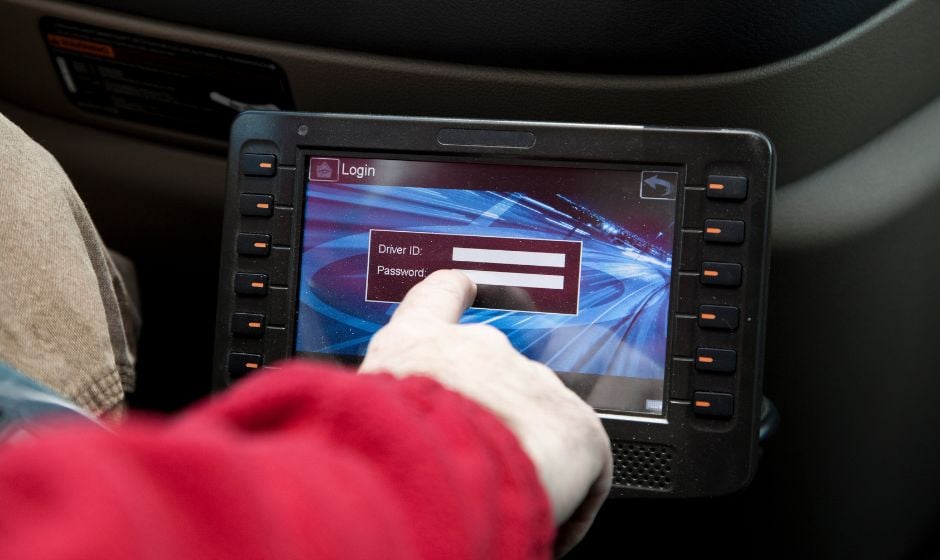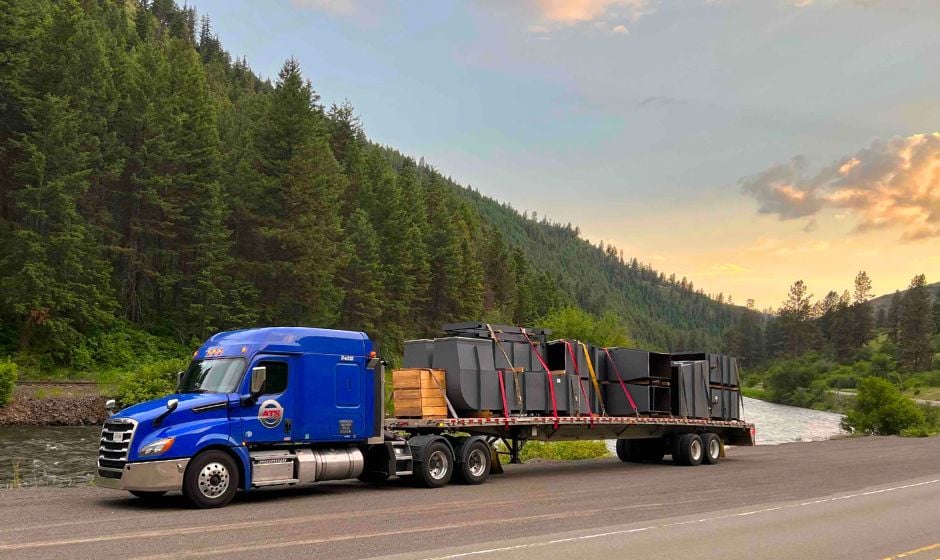
It’s true: I’m a package-tracking enthusiast. I get a thrill when my email inbox pings with that all-important tracking information. I delight in watching my parcels move through the country, and I eagerly anticipate their arrival at my doorstep.
The epic highs and lows of shipping are not for the faint of heart. Who among us hasn’t mourned a package inexplicably stalled in Salt Lake City for days? But the peace of mind I get from knowing exactly where my new Adidas Ultraboost are makes it all worth it.
Okay, fine — maybe my zeal for tracking is a bit much. But I have the same mindset as any freight shipper or receiver! Just as consumers expect detailed parcel tracking information, shippers expect high-quality freight tracking, too.
Since Anderson Trucking Service (ATS)'s start in 1955, we’ve seen trucking tracking evolve at a rapid pace. Thanks to 70 years of technological advances, we can now track loads at every stage of their journey.
If you’re a shipper wondering what your options are for tracking freight, we have you covered. Our guide to all things trucking tracking will help you better understand your options for tracking your freight. We'll also provide insights about how tracking data can help you optimize your supply chain.
Related: 2025 Freight Shipping Calendar
Along the way, we’ll cover variances in tracking capabilities, red flags, and more!
- How can shippers track freight?
- What's the difference between ELD and mobile app freight tracking?
- Is it standard for carriers and brokerages to provide tracking?
- Why is freight tracking important to shippers?
- Does freight tracking cost extra?
- What happens when a freight shipment gets lost?
How Can Shippers Track Freight?
Freight tracking is not standardized across transportation providers. The industry uses a variety of digital solutions to track loads. The most common freight tracking methods are electronic logging devices (ELDs) and web-based tools.
Electronic Logging Devices (ELDs)
Located in the cab of a truck, ELDs record drivers’ on-duty service hours. ELD use is government-mandated for all truck drivers, unless they fall under a specific exemption category.
ELDs integrate with load-tracking software to deliver tracking data. Shippers and carriers then use electronic data interchange (EDI) software integration to pass this data back and forth, even if they have different equipment and programs.
This streamlined communication can make operations more efficient for shippers and carriers alike. ELD data can help shippers prepare for a truck’s arrival and reduce loading times, unexpected accessorials, and overtime charges.
ELD and EDI integration can be a worthwhile investment for shippers interested in the highest possible level of visibility. This is a popular solution for major shippers with large, consistent shipments hauled on a contract basis.

Mobile Apps & Online Tracking
Mobile trucking tracking apps use the driver’s smartphone GPS, cell tower data, or geofencing to provide load tracking. There are many app-based freight tracking platforms out there, but some of the most popular include:
- Macropoint
- Trucker Tools
- Project 44
- FourKites
- Broker-specific apps created by brokerages themselves rather than a third-party developer
Mobile apps are a particularly carrier-friendly means of load tracking. Their implementation is low-cost and can be quickly downloaded to drivers’ phones. Shippers appreciate the convenience of having timely load tracking data literally in their pocket at all times, though this method does rely on drivers to download the app and keep their phones powered on.
Outside of the App Store, many freight companies will also offer online load-tracking portals. This allows shippers who do not want to become EDI-capable (usually because of the cost to buy and implement) to track their freight.
At ATS, we offer both to give our customers the highest possible degree of accessibility:
- Customers can log in to the ATS Customer Portal to access real-time load-tracking data and documentation.
- The ATS Load Tracker, in contrast, does not require customers to log in. Instead, customers provide their shipment information — including approximate ship date and origin, load number, bill of lading (BOL) number, purchase order number, and consignee reference number — to view tracking data.
What’s The Difference Between ELD and Mobile App Freight Tracking?
For shippers, the functional differences are minimal. Both methods will allow you to track loads in real (or close-to-real) time.
But you may notice a difference in the frequency and accuracy of your tracking updates.
ELD tracking is more accurate than app-based tracking. Shippers and carriers that want frequent, detailed updates may prefer ELDs for this reason. ATS’s assets, for example, have ELDs that can update shippers every two minutes.
On the other hand, mobile apps allow carriers and brokerages to choose how often clients receive updates. Common intervals include every 15 minutes, every 30 minutes, every 2 hours, and so on.
This flexibility can be helpful for brokerages working with a variety of customers (and a variety of communication preferences).

However, when it comes to location tracking, not all mobile apps are created equal.
Many trucking tracking apps use geofencing or cell-phone tower data to track loads. These methods are much less accurate than using smartphone GPS or ELD data.
As you may imagine, accuracy is paramount in trucking tracking. Inaccuracy affects more than just ETAs; geofencing-based apps can sometimes report a truck's "arrival" some 30 miles from its actual destination. The confusion that follows can be disruptive at best and costly at worst.
If you have a strong preference for a certain type of tracking, keep that in mind as you consider adding providers to your network. Ask any prospective carriers or brokerages about their tracking methods to ensure you get the level of visibility you need.
Is It Standard For Carriers and Brokerages to Provide Tracking?
Yes, it’s standard for transportation companies to provide tracking information to customers.
Beyond delivering peace of mind to customers like you, it’s in the provider’s best interest to know where your shipment is at all times.
For asset-based carriers, this helps create a smooth flow of trucks, lanes, and loads.
For brokerages, freight tracking can help prevent communication snags, double-brokering, and other issues.
If you’re vetting a carrier or brokerage that does not (or refuses to) provide tracking of any kind, that’s a red flag. It is well within your rights to request regular communication about the location of your freight. At the very least, a responsible partner will keep you updated on your shipment’s progress via frequent phone calls.
Related: How Do Freight Brokers Track Shipments?
Does Freight Tracking Cost Extra?
It shouldn’t! Freight tracking should not add costs to the shipper’s final bill.
It's true that becoming EDI-capable and outfitting trucks with ELDs has associated costs for providers. But reputable partners won't jack up your pricing an extra $50/load if you want to track your shipments.

What Happens When a Freight Shipment Gets Lost?
While truck tracking makes it difficult to outright lose a shipment, it does not prevent theft, delays, lost drivers, etc.
Related: The Top 10 Reasons Why Shipments Fail
As a shipper, your experience with a lost, stolen, or delayed shipment will depend on whether your load was tracked.
If your shipment was not tracked, you’ll rely on your broker or carrier to provide updates from the driver. The flow of information may not be as quick or frequent as you might like, and you may feel a lack of control over your supply chain.
If your shipment was being tracked, it’s easier for your provider to get a handle on the situation and make it right.
When a truck’s EDL stops transmitting, for example, the carrier can look to its previously-reported data. The carrier can follow the truck’s path, see its speed and time of arrival in each city, and use that information to determine where the truck might be.
Tracking acts as a second line of defense (after consistent driver communication) against confusion, delays, and potential losses.
Related: Why Truck Driver Experience and Quality Should Matter to Your Supply Chain
The bottom line for shippers? Choose a provider with a reputation for accountability, responsibility, and communication in addition to robust load tracking capabilities. Your supply chain will thank you!
Why Is Freight Tracking Important to Shippers?
Simply put: Everyone feels better if they know where their stuff is! Freight tracking gives shippers like you peace of mind and visibility into their freight’s progress.
Virtually every part of a shipper’s operations can be informed and improved by reliable, accurate tracking data.
Early identification of risks, better resource management, increased customer satisfaction — shippers can achieve all this and more by leveraging tracking technologies.
For shippers, knowledge is power. Whether your provider uses ELDs, mobile apps, customer portals or other tools to gather and send tracking data, the information delivered by these methods can be instrumental to the health of your supply chain.

In this modern day and age, reputable providers offer one or more means of freight tracking, plus the ability to choose the update interval and level of detail that works for you. Tracked shipments are more likely to reach their destination safely and on time, and if any problems arise during shipping, tracking can get things back on, well, track.
Still, even with high-quality tracking technologies in place, some providers struggle to meet customer needs. At ATS, we want you to find the best-fit providers for your network — even if we’re not among them!
That’s why we created a free Transportation Provider Scorecard. This downloadable resource will help you monitor and assess (one might even say . . . track) your providers’ performance to ensure your supply chain is operating at peak efficiency and effectiveness.
If you have more questions about freight tracking, you can always reach out to ATS. We’ll be happy to provide all the information you need to make the best decisions for your business.




